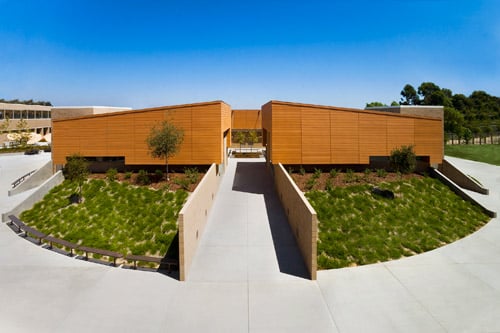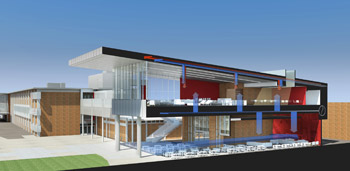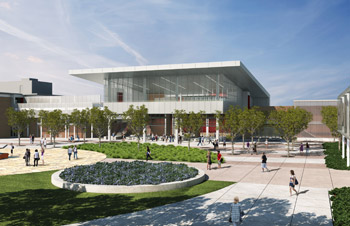Sustainable Planning and Design in K-12 Schools: Part 4
If you follow K-12 School Design like I do, you’ll notice that districts across the country are going green to save green. Although schools are closed for summer vacation, there is no vacation from the funding cuts that most every school is experiencing.  Simple steps that improve a school’s indoor environment cost nothing. Abundant natural daylight, outdoor views, and fresh filtered air don’t come with a high price tag—and yet, they’ll make your classroom feel like a million-dollar educational space.
Simple steps that improve a school’s indoor environment cost nothing. Abundant natural daylight, outdoor views, and fresh filtered air don’t come with a high price tag—and yet, they’ll make your classroom feel like a million-dollar educational space.
A school building’s shape can go a long way toward making it green and creating a top notch indoor environment. A narrow building, for example, supports both natural daylighting and natural ventilation strategies. So does a circular or cylindrical design. Both strategies also help to reduce a building’s development footprint.
Strategies for abundant natural daylighting include large windows with low-emission (Low-E) glazing, atriums, clerestories, skylights, light monitors, light shelves, and glass curtain walls.
Natural ventilation goes a long way toward achieving the best indoor air quality. Several strategies support a natural ventilation system, from building orientation and shape—as mentioned above—to operable windows, double curtain walls, and wind chimneys.
A double curtain wall system has a façade of two separate panes of glass separated by a 30-inch air space, which not only brings natural daylight into the building and gives users spectacular outdoor views, it also vents heat out the top of the building, and on cold days it captures warm air to help heat the building.
Wind chimneys have been used for centuries from the American Southwest to the Middle East and India for natural ventilation of a building interior. A wind chimney can be as simple as a rooftop chimney designed to use temperature and pressure differentials to drive clean fresh air into and through a building. A wind chimney can also be a more complex system, like a tower sunk from three to several feet into the ground and attached to a building that draws cool air up from the earth (which has a stable, cooler temperature than above-surface air) and into the building. When it is cold outside at night, this wind chimney system draws air up from the earth that warms the building floors.
 Temperature is a critical component of indoor environmental quality. A growing number of energy-efficient heating and cooling technologies are helping buildings become more sustainable while making occupants more comfortable, starting with underfloor air distribution systems, or displacement ventilation, which deliver conditioned air at a lower velocity just above floor level. The conditioned air rises naturally and disperses throughout the space. This delivery system uses lower fan pressure and speeds, and therefore less energy, than conventional HVAC systems.
Temperature is a critical component of indoor environmental quality. A growing number of energy-efficient heating and cooling technologies are helping buildings become more sustainable while making occupants more comfortable, starting with underfloor air distribution systems, or displacement ventilation, which deliver conditioned air at a lower velocity just above floor level. The conditioned air rises naturally and disperses throughout the space. This delivery system uses lower fan pressure and speeds, and therefore less energy, than conventional HVAC systems.
 An inexpensive and energy-efficient HVAC strategy is night flushing, which uses a system of fans and vents to push warm interior air out of a building at night and draw in the cooler evening air, which delays heat gain during the day, and that reduces the cooling load. Night flushing also helps to keep the indoor air fresh by ejecting stale air.
An inexpensive and energy-efficient HVAC strategy is night flushing, which uses a system of fans and vents to push warm interior air out of a building at night and draw in the cooler evening air, which delays heat gain during the day, and that reduces the cooling load. Night flushing also helps to keep the indoor air fresh by ejecting stale air.
Maintaining good indoor air quality requires proactive building operations plans, including cleaning procedures, the use of low- and zero-VOC cleaning products, and regular maintenance and monitoring of the HVAC system.
In Part Five of this Sustainable Planning and Design in schools series, we’ll get more into design—from a school’s façade to its roof, and how to save energy through the process.
Dave Gilmore has more than 30 years of experience in the architectural design industry. A Principal at LPA Inc., Gilmore has left his mark on more than 200 K-12 schools. He has additional expertise in urban planning, commercial, retail, institutional, mixed-use and public architectural design. Dave is a LEED accredited professional (AP), and an active member of the American Institute of Architects (AIA) and the Coalition for Adequate School Housing (C.A.S.H.).
